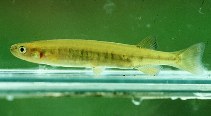| Family: |
Galaxiidae (Galaxiids), subfamily: Galaxiinae |
| Max. size: |
19 cm SL (male/unsexed); max. reported age: 5 years |
| Environment: |
benthopelagic; freshwater |
| Distribution: |
Oceania: endemic to southwestern Western Australia. |
| Diagnosis: |
Dorsal spines (total): 0-0; Dorsal soft rays (total): 7-10; Anal spines: 0-0; Anal soft rays: 11-14; Vertebrae: 50-54. Adults have a flattened head and a flattened snout, and are olive-green dorsally and silver-white ventrally, with dark bars laterally. No scales. |
| Biology: |
Found in rocky pools at the base of rapids and waterfalls. Occur around submerged vegetation along the edges of pools or slow-flowing water and sometimes in lakes and ponds (Ref. 6896, 33843). Water is usually clear and fresh or darkly tannin-stained and slightly acidic. Tolerate brackish conditions found in many salt-affected rivers of the south-west. A fast swimming species, forming moderately-sized shoals just above the bottom. With the onset of winter rains, these fish move into small tributaries and feeder streams of rivers and wetlands to spawn among flooded vegetation. Sexual maturity is reached the following autumn (Ref. 44894). Feed mainly on insects and small crustaceans. Considered as the most abundant freshwater fish species in southwestern Western Australia (Ref. 6896, 33843, 44894). |
| IUCN Red List Status: |
Least Concern (LC); Date assessed: 14 February 2019 Ref. (130435)
|
| Threat to humans: |
harmless |
Source and more info: www.fishbase.org. For personal, classroom, and other internal use only. Not for publication.

